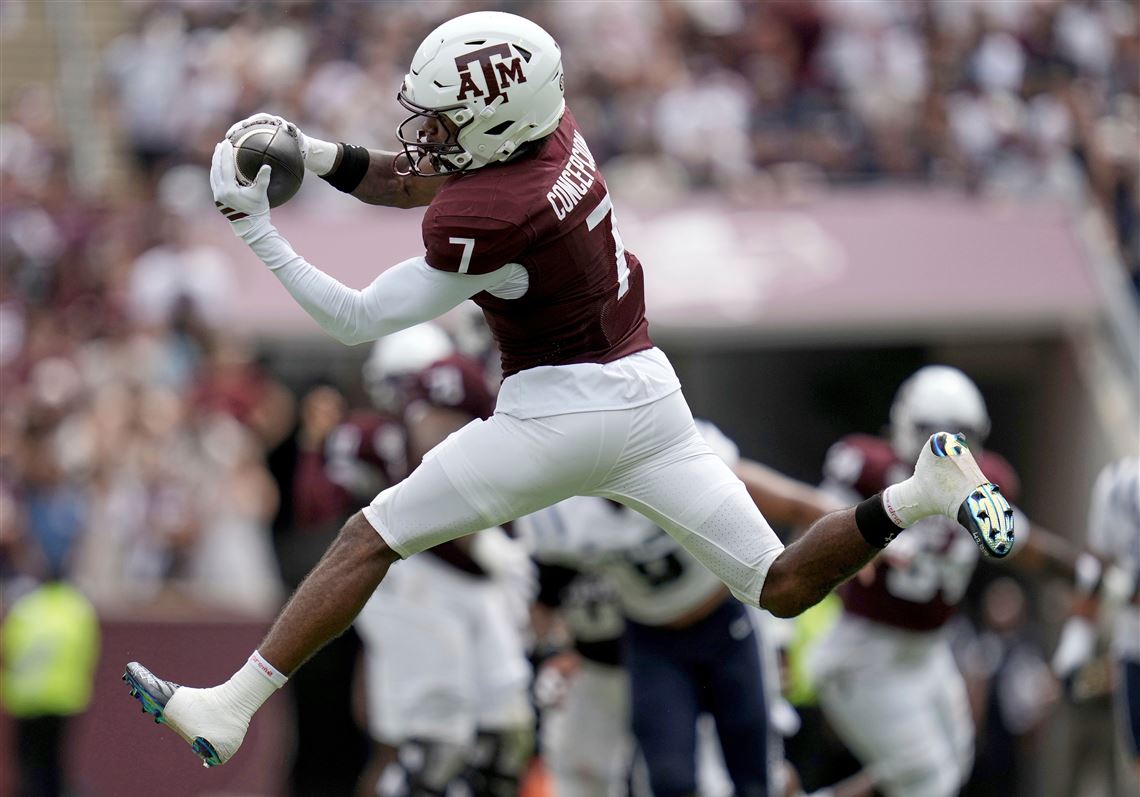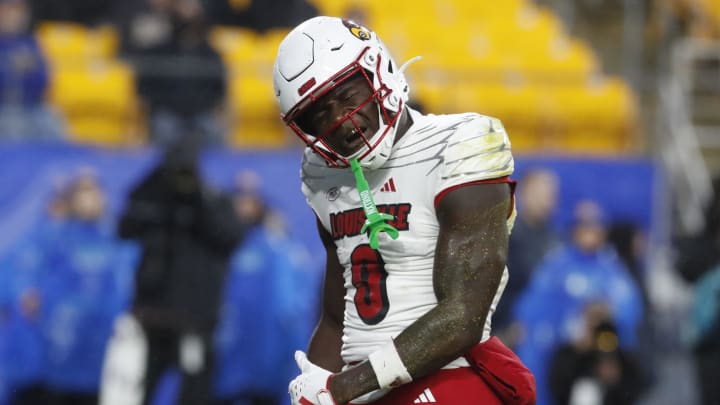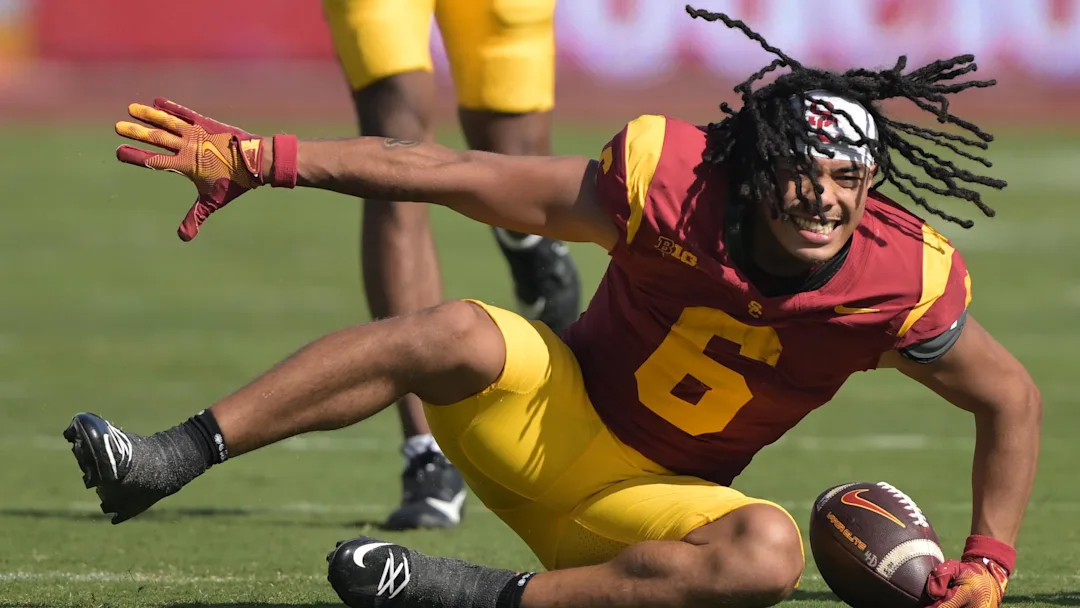By Charlie Campbell.
Send Charlie an e-mail here: [email protected]
Follow Charlie on Twitter @draftcampbell for updates.
This page was last updated Feb. 26, 2021. Follow me @walterfootball for updates.
Position Review: Running Backs
Running Back Class
Early-round talent: B
Mid-round: B
Late-round: B
Overall grade: B
2021 prospects vs 2020
Clyde Edwards-Helaire
Najee Harris
D’Andre Swift
Jonathan Taylor
Cam Akers
J.K. Dobbins
Travis Etienne
Javonte Williams
Kenny Gainwell
A.J. Dillon
Antonio Gibson
Kylin Hill
Rhamondre Stevenson
Larry Rountree
Ke’Shawn Vaughn
Trey Sermon
Just to be clear this article and series is all my opinion based off my own study and information I’ve gotten from general managers, directors of college scouting, national scouts, area scouts, and NFL coaches who know way more than I do.
The 2020 NFL Draft featured a strong class of running back talent, and while the 2021 NFL Draft is similar, the class maybe not quite as talented. Last year from the end of the first round to early in the third round, six running backs were selected. That many backs won’t go in the top 70 this year.
If you were to merge the two classes together, Clyde Edwards-Helaire would be the top back, but he is barely ahead of Najee Harris and D’Andre Swift. I personally liked Jonathan Taylor, Cam Akers and J.K. Dobbins more than I like Travis Etienne and Javonte Williams. I prefer Kenny Gainwell more than the consensus and think he could be a steal. I think Kylin Hill and Rhamondre Stevenson are early third-round caliber players like Antonio Gibson. I think Larry Rountree is comparable, but slightly better than, Ke’Shawn Vaughn, who I slotted just ahead of Trey Sermon.
Safest Pick: Najee Harris, Alabama

Previous Picks:
2020: D’Andre Swift
2019: Josh Jacobs
2018: Saquon Barkley
2017: Leonard Fournette
2016: Ezekiel Elliott
2015: Melvin Gordon
2014: Carlos Hyde
2013: Eddie Lacy
The track record here is pretty good, with only Hyde being a true disappointment at the NFL level, but he went to a bad team in some down years.
This was an easy choice with Harris, who looks like a safe bet to turn into a quality three-down starter. Harris (6-2, 230) is a big running back who has the build and strength to be a bell-cow back who handles a large work load at the NFL level. On top of being a power runner, Harris is a quality receiver who shows good potential as a blocker and blitz protector. Harris may not become one of the elite backs in the NFL, but he should be turn into a good starter and have Pro Bowl potential.
Biggest Bust Potential: Chuba Hubbard, Oklahoma State

Previous Picks:
2020: A.J. Dillon
2019: David Montgomery
2018: Rashaad Penny
2017: Wayne Gallman
2016: Kenneth Dixon
2015: Mike Davis
2014: Lache Seastrunk
2013: Montee Ball
Overall, this bust list is looking pretty accurate. Montgomery flashed some good and bad in his first two years, but it is too early to pass definitive judgement on him. Penny has been a backup and bust thus far, and Gallman likewise is stuck as a backup. Dixon didn’t work out. Davis has been a journeyman, but he played really well for Carolina in 2020. Seastrunk never made it in the NFL, although he fell deep in the 2014 NFL Draft. Ball was a huge bust for the Broncos, which I could see coming.
This was a tough choice because no running back is really jumping out at me this year. I chose Hubbard because he does not have special speed and is not a bruiser. Hubbard also is a liability in pass protection, even looking disinterested at times in 2020. Hubbard could be selected on Day 2 of the 2021 NFL Draft with the expectations to develop into a starter, but I think he may end up topping out as backup journeyman in the NFL.
Running Back Rankings by Attributes
Natural Running Ability:
NFL prototype: Adrian Peterson, Free Agent
- Najee Harris
- Javonte Williams
- Travis Etienne
- Kenny Gainwell
- Larry Rountree
- Kylin Hill
- Trey Sermon
- Rhamondre Stevenson
Recap: There are still a number of coaches in the NFL who want an old-school approach of a running-based offense. Additionally, a lot of passing-led offenses want a back who can wear down defenses in the second half.
Harris is a natural runner with good instincts. He shows excellent vision, patience and anticipation to follow his line before bursting downhill. When holes aren’t open, Harris will patiently wait to let his line create a crease and them skillfully use his vision to make something out of nothing. Harris anticipates where a hole is about to open, and that lets him get to the second level consistently.
With his power, size, and tough rushing style, Williams is a downhill runner who can impose his will through sheer strength. Using his strong build, knee bend, and ability to run behind his pads, Williams breaks a lot of tackles and picks up yards after contact. Defenders will really struggle to bring him down at the second level, and it often take multiple tacklers to get him to the turf. With his contact balance and strength, Williams is a true power back to wear out defense.
Etienne demonstrates very good running fundamentals, like the patience to let holes develop, the vision to see lanes about to come open, and good body lean to run behind his pads. While Etienne is not a big back, he does flash some nice contact balance to maintain his feet after contact, and he has a nose for the end zone.
Gainwell is tougher between the tackles than would think from the eyeball test. He runs with natural body lean and knee bend to stay behind his pads. While Gainwell is not big, he has impressive balance and shows the ability to fight through some contact.
Rountree is a natural runner with quality moves and cutting ability to dodge tacklers. He has good feet and knee bend, an ability to run behind his pads and a burst to break off long runs.
Hill has good vision, body lean, runs behind his pads, and is patient. He sets up blocks and uses his speed to dart through holes before they close. Defenders can struggle to get a hold of Hill as he has good feet that make him elusive. He is sudden with his ability to cut and change direction.
Stevenson and Sermon are both hard-nosed runners who run angry and often bring pain to the defenders trying to tackle them. They are both powerful downhill runners. Stevenson shows serious aggression to run through defenders and power through them to continue to add yards. Sermon has a strong build that makes him tough to bring down. Both of them have the lower body strength to move the pile, and they keep their legs moving after contact. In the open field, Stevenson and Sermon both show a second gear and do a better job of running away from the defense than one would expect for backs of their size.
Pass Receiving:
NFL prototype: Christian McCaffrey, Panthers
- Kenny Gainwell
- Travis Etienne
- Najee Harris
- Kylin Hill
- Larry Rountree
- Javonte Williams
- Rhamondre Stevenson
- Trey Sermon
Recap: The passing-driven NFL has many offensive coordinators emphasizing a running back’s’ ability to help the aerial offense over their running ability. Coaches want backs who have good hands, run good routes and can rack up yards as outlet receivers. This group is very good overall, as the majority are good receivers out of the backfield. None of them, however, is a Christian McCaffrey-type back who could legitimately line up as a slot receiver like McCaffrey can.
Gainwell is a dynamic receiver who has the ability to line up as a slot receiver, and his 51 receptions in 2019 were no fluke. He has dangerous route-running ability with explosion and shiftiness to generate separation. On wheel routes, slants, digs, crosses, and screens, Gainwell is dangerous threat to turn a short pass into a big play. With his soft hands, Gainwell is natural catching the ball. He is elusive in the open field and can rip off yards in chunks. Gainwell is too fast and shifty for linebackers or safeties to cover in man, so he provides an excellent mismatch and will be a third-down receiving weapon in the NFL.
Etienne showed real improvement in terms of receiving as a senior. His hands and route-running looked much better. Etienne catches the ball with his hands and is able to run some good routes. He has the potential for the NFL to be a good receiving back who is a dangerous weapon to rip off yards in chunks on check downs to the flat. Etienne can turn a routine pass into a big play, and he could be a good contributor to a pro passing attack.
Harris has good hands for a power back. He makes some difficult catches and is dangerous in space. Harris is not a shifty receiver, but he should be a good check-down option. Over the past two seasons, Harris totaled 70 receptions and really improved in his route-running. Harris may not be a dynamic receiving back in the NFL, but he should be a solid contributor.
Hill is well-suited for the passing-driven modern game because he is a talented receiving back. He runs good routes out of the backfield and has soft hands. Over the past three seasons, Hill totaled 63 receptions and was a steady and reliable check-down option who was dangerous as a receiver. Hill is too fast and shifty for linebackers in man coverage, so he will give his NFL team a mismatch weapon who will be valuable on third downs.
In the passing game, Rountree is a weapon as a check-down receiver. He has soft hands and finds the soft spots to get open for his quarterback. Rountree is quick, sudden and shifty, making it tough for linebackers to cover him, so he could be a mismatch contributor.
Williams shows the ability serve as a receiving-down back in the passing gameHe has quality hands, runs solid routes for a big back, and shows vision and feel to find the soft spots in defenses. While he only had 29 receptions in college, he showed the potential to do more than that. He had 19 catches in 2020, with Michael Carter getting more receiving opportunities in North Carolina’s committee approach.
Sermon and Stevenson have functional hands for power backs, but they did not see many receiving opportunities in college. They can do more than was seen at Oklahoma and Ohio State, but they’re not dynamic weapons for the passing game at the next level. Stevenson could contribute on check downs and by running down hill after making the catch. He also has the potential to be a potent back on screens.
Pass Blocking:
NFL prototype: Ezekiel Elliott, Cowboys
- Najee Harris
- Travis Etienne
- Larry Rountree
- Javonte Williams
- Trey Sermon
- Rhamondre Stevenson
- Kenny Gainwell
- Kylin Hill
Recap: This is huge for offensive coordinators. If a running back can’t pass protect, they are going to have a hard time seeing the field in the NFL. If the defenses know that a running back isn’t trusted to protect the quarterback, it is an immediate tip about what the play is going to be. Coaches want multiple backs with pass-protection skills. The importance of blitz pickup and pass blocking are increasing every year for running backs.
None of these backs are as good as Ezekiel Elliott was entering the NFL, but a lot of them have potential. Harris is a tough blocker who will take on blitzers and is smart at identifying the correct player to block. He received good grooming in a pro scheme and tailback responsibilities under Steve Sarkisian. Once Harris gets some development with learning NFL blitz schemes, he could be a real asset in the passing game as a reliable quarterback protector.
In blitz protection, Etienne showed development as a blocker and didn’t shy away from contact. He made strides as he gained experience, and while he isn’t the biggest of backs, he could be functional in pass protection as a pro.
Rountree, Williams, Sermon, Stevenson and Hill all flashed some blocking potential. They all have enough size to square up blitzers and take on defenders. Gainwell’s size could prevent him from ever being a good blocker in pass protection.
Yards After Contact:
NFL prototype: Todd Gurley, Free Agent
- Najee Harris
- Javonte Williams
- Rhamondre Stevenson
- Trey Sermon
- Larry Rountree
- Kylin Hill
- Travis Etienne
- Kenny Gainwell
Recap: For running backs to be consistently successful in the NFL, they have to have the ability to pick up yards after contact. Breaking tackles is critical to moving the chains and setting up good down-and-distance situations. This group offers an excellent set of prospects who can pick up yards after contact.
Harris has an excellent combination of size and quickness that lets him run over tacklers, yet he retains the speed to hit the hole. Harris has a strong build and is difficult to bring down, as he will power through tackles and bounce off defenders to continue to gain yards. He has very good contact balance and runs behind his pads with nice knee bend. In short yardage, Harris is an asset because he can push the pile on his own. He keeps his legs going after contact with a powerful lower body that is tough to stop.
With his strong build, knee bend, and ability to run behind his pads, Williams breaks a lot of tackles and picks up yards after contact. Defenders will really struggle to bring him down at the second level, and it often take multiple tacklers to get him to the turf. With his contact balance and strength, Williams is a true power back to wear out defense. His strength to run through tackles and push the pile makes him an asset in short-yardage and goal-line situations, with his 2020 touchdown total – 19 – showing proof of his ability to produce in the condensed portion of the field.
Stevenson is a hard-nosed runner who runs angry and often brings pain to defenders who try to tackle him. Coming downhill, Stevenson shows serious aggression to run through defenders and power through them to continue to add yards. He has the lower body strength to move the pile, and he keeps his legs moving after contact. The 6-foot, 232-pound Stevenson is a load as a runner and racks up lots of yards after contact.
Sermon has a strong build that provides him with some power to run through tackles and pick up yards after contact. He has plus balance to maintain his feet after getting hit by defenders, and he uses his stature to run through would-be tacklers.
Rountree has the upper body strength to fight off tacklers and pick up yards after contact, and he runs hard. With his compact build and his lower and upper body strength, he should be able to contribute in short-yardage and goal-line situations with an ability to charge through defenders.
While Hill is not overpowering, he has the strength to pick up yards after contact with the balance to sustain hits and a strong build to finish his runs well. Hill runs hard, and he pushed through contact consistently at Mississippi State. Hill also finishes runs well, delivering some blows to defenders while falling forward.
Etienne and Gainwell run hard for undersized backs, and they get more yards after contact than one would think. Both of them were able to generate yards after contact in college, but I think it will be more difficult for them to do that in the NFL given the larger and stronger defenders.
Zone-Blocking Runner:
NFL prototype: Ezekiel Elliott, Cowboys
- Najee Harris
- Javonte Williams
- Rhamondre Stevenson
- Trey Sermon
- Larry Rountree
- Kylin Hill
- Travis Etienne
- Kenny Gainwell
Recap: The zone-blocking scheme calls for backs to have quickness and physicality. They need the ability to follow the moving wall, use vision and anticipation to see the hole opening and make one cut to run downhill. It is a different type of running compared to a set, designed play. There isn’t a running back in this group who would be a poor fit for a zone scheme.
There is a lot to like about Harris, Williams, Stevenson and Sermon in zone-blocking systems. They all are hard-charging downhill hill backs who have a quick first-step to hit the hole before it closes and a second gear to get to the secondary. Williams is an excellent fit for a zone-blocking system because he thrives as a one-cut downhill runner. Harris has good vision and cutting ability and is a decisive runner to hit the hole with the power to churn through arm tackles.
With Stevenson’s size and strength, he is tough for defensive backs to tackle, and he dishes out some ferocity when going through defenders. He would be a great fit in a zone-blocking scheme.
Sermon would be another dangerous one-cut downhill runner, as he is imposing with his strength to run through tackles and keep his legs going downfield. Rountree is similar and could excel in a zone scheme if he lands with a team that has a good offensive line. Hill is faster than expected and keeps his legs moving under contact.
Etienne and Gainwell can run some zone plays, and both have the burst to dart downfield. They could be better in a man schemes, but they have enough ability to execute plays in zone schemes.
Power-Man Runner:
NFL prototype: Alvin Kamara, Saints
- Travis Etienne
- Kenny Gainwell
- Kylin Hill
- Najee Harris
- Larry Rountree
- Trey Sermon
- Javonte Williams
- Rhamondre Stevenson
Recap: Etienne is a great fit for a man scheme. Defenders really struggle to get a hold of him because he has great feet that make him very elusive. He is sudden with his ability to cut and change direction. Etienne has a dangerous jab step with cuts back to the inside, and he uses it to make tacklers grab air. His abrupt juke even works on defensive backs. With his change-of-direction skills and quick feet, Etienne can create big runs on his own even when blocking assignments are missed.
With excellent feet, Gainwell has serious elusiveness in the open field, allowing him to cut and weave his way around defenders. He is very shifty and lateral quickness to dodge defenders. Gainwell would be a great fit in a man scheme.
Hill could fit well in a man scheme because he can create on his own. He should appeal to power-man schemes with his ability to make things happen and dodge defenders.
Harris could function in a man scheme because he has enough elusiveness to go with his power that he could create on his own in a variety of ways. At Alabama, Harris showed the ability to run the ball well in man or zone schemes.
Rountree can do it by himself if necessary, and that was clear throughout his time at Missouri, where his offensive line was nothing special. He had to make something out of nothing routinely versus SEC foes.
Sermon, Williams and Stevenson are more of a one-cut downhill runners. While they each have some lateral quickness, they are more of North-South runners.
NFL Picks - Dec. 27
2026 NFL Mock Draft - Dec. 24
NFL Power Rankings - Dec. 23
Fantasy Football Rankings - Sept. 1




